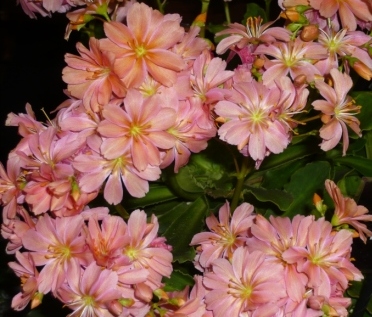Lewisias Updated Information
I have talked before of Lewisia becoming trendy and offered some growing tips.
I have had more years of experience and like the way my plants are performing.
The above plant is flowering amongst the old leaves of the primula that cropped up in the sandy soil of my rockery.
Description of Lewisia
- From the Portulacaceae family most Lewisias could almost be mistaken for succulents.
- They produce thick or fleshy, green, shiny waxy leaves in rosettes
- Lewisia grow 6-10″ high and flower on straight stems that are prone to lean over.
- Flowers are profuse, round-shaped and occasionally doubles or semis.
- Lewisia blooms come in bright pink, apricot, white, or plum red.
- Most varieties are evergreen but resent damp on the leaves.
Tips for Growing Lewisia From post ‘Lewisia Trendy, Bright and Breezy’ Aug 2013
- Whilst Lewisia are perennial plants are very susceptible to winter wet rot. Over winter under glass if needs be.
- As Lewisia are very low growing it is common to grow in pots or containers so the flowers can be seen.
- The clump forming Ashwood Strain is recommended as a particularly good mix producing large semi-double flowers in a wide range of colours.
- With judicious deadheading Lewisia will bloom from April to the end of September, particularly if kept in an alpine house or cold greenhouse.
- In an Alpine garden surround the base of the plant with rock chips to prevent rot. Lewisias prefer sites with abundant spring moisture followed by a dry, cool summer.
- Other species to try include Lewisia; Pygmea, Rediviva, Brachycalyx, or hybrids Heckneri or Phyllellia Obtain plants from Pottertons and various nurseries or your local garden centre.
Varieties of Lewisia
- Lewisia rediviva, also called bitter root lewisia has thick, fleshy, deciduous leaves and pink to white flowers. Detailed growing information is available here.
- Lewisia cotyledon has persistent leaves and grows in the form of mat like rosettes. ‘Little Plum’ has deeply veined flowers in white with pink or red stripes.
- Hybrid lewisias are available as inexpensive seed mixtures.
- The Alpine garden society lists 100 cultivars and species and in the Alpine Gardener vol 82 No 3. there is a wealth of knowhow about Lewisia cotyledon one of the colourful and popular species.
- Lewisia tweedyi is shorter at 6″ tall but has 3″ wide blooms in white and cream. Great for a rockery or alpine house.
- Groups include cotyledon, pygmaea and rediviva.
Bibliography and Sources
Lewisia Roy Elliot AGS
Kew Lewisia monograph series. The main concern in this work is with the nineteen species of the genus Lewisia, a
More Photographs of Lewisia
National collection of Lewisia can be seen at Ashwood Nurseries



3 thoughts on “Lewisias Updated Information”
Comments are closed.